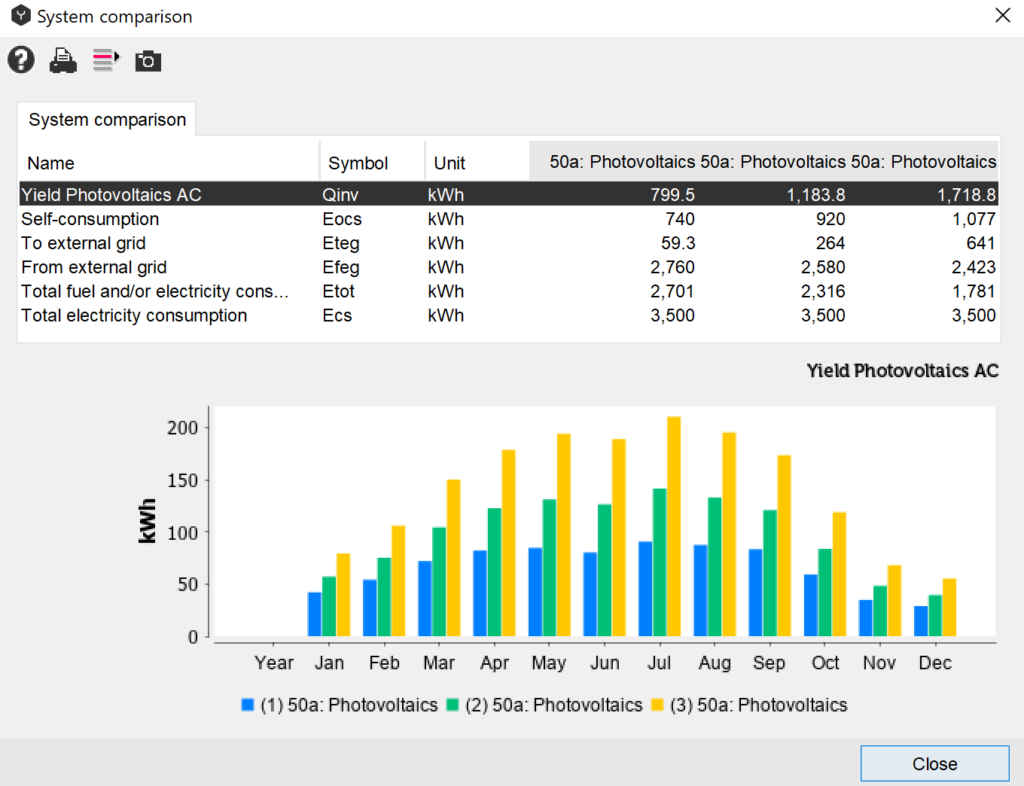Results Overview and System Comparison
An overview of primarily used results is given. By selecting a result, the respective graph with monthly values is displayed at the bottom of the window.
Reference System Diagram
Polysun allows the use of reference system diagrams for the analysis and enhancement of solar energy systems. To this end a system diagram may be specially labelled within the project tree (right mouse click – „System diagram as reference…“).

Important values like, e.g. Solar savings (Fractional solar savings, Fss) may only be calculated with the aid of the definition of a reference system. Solar savings are defined as follows:
\(Fss\ = 1 – \ \frac{(Eaux – Epar)sol\ }{(Eaux – Epar)ref}\)
where Eaux refers to the Auxiliary energy and Epar refers to the Parasitic energy of the respective system („sol“ = solar energy system, „ref“ = reference system)
Example: In a solar energy system, system diagrams with and without solar input are required to be compared. To this end a model is applied as a system diagram in the project. Copy the system diagram (right mouse click – „Copy system diagram…“) and alter it so that the pump in the solar loop is not running. This system diagram will then be set as a reference (right mouse click – „System diagram as reference…“). Once the simulation results from both system diagrams are available the solar savings FSS will be shown in the results.
Discussion: For customer service purposes and more in particular in a retrofitting situation the existing heating system too may be recreated in detail and set as a reference. This will enable to figure out the expected solar savings with a new solar energy system.
Tip: In the Options – Settings – Simulation menu you will be able to select when Polysun should calculate the reference system:
- „Simulate reference upon confirmation“: the user should confirm the start of the reference simulation
- „Simulate reference without confirmation“: the reference simulation will be restarted immediately after the simulation of a system diagram
- „ Do not simulate reference“: the reference simulation will not be automatically simulated and the user must start the simulation manually
System Comparison
For the technical evaluation and performance analysis of different system diagrams in one project the user can choose “System comparison” from the drop-down list of the Polysun menu bar Results. This feature allows the user to see how a change in the system design influences the system performance. In addition, it allows the fast examination of the system behavior with different system designs. An example of the results window is shown below.

The results comparison shows main performance indicators for a given technology of the active systems in the project in tabular and graphical form. By left clicking on the correspondent parameter the values over the year will be displayed graphically. The system comparison can be printed out in a separate pdf-document by clicking on the “Print” button on the top of the window.
Total CO2 Emissions and CO2 Savings
The CO2 (equivalent) emissions are estimated for any component which consumes electricity or a fuel. Life-cycle emissions of components such as PV, batteries, or electric vehicles, are neglected. For fuel consumers (e.g., boilers, generators, co-generators), the emissions are estimated as follows:
\(emissions = specific\ emissions \cdot fuel\ consumption\)
whereby the specific emissions are defined in the “Energy Source” catalog.
For electrical consumers, the emissions are:
\(emissions = specific\ emissions \cdot E_{fromGrid}\ \)
where \(E_{fromGrid}\) is the electrical energy purchased from the grid.
To estimate the total CO2 emissions of a system, Polysun requires it to have an electric grid and electric consumers, so that own consumption and feed-in limitations can be considered. Given these conditions, Polysun displays the system’s total emissions in the results overview. Additionally, if a reference system is defined, the CO2 savings compared with the reference system are shown.